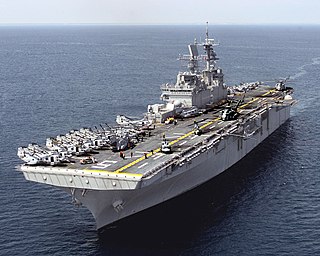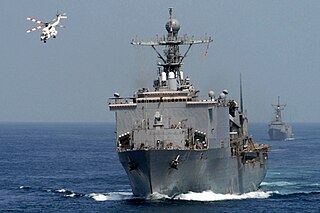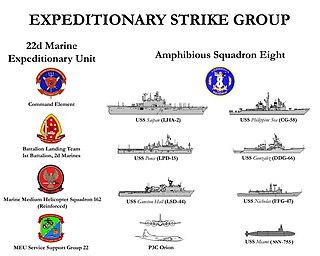
USS Kearsarge (LHD-3) is the third Wasp-class amphibious assault ship of the United States Navy. She is the fifth ship to bear that name, but the fourth to serve under it, as the third was renamed Hornet (CV-12) before launching.

USS Tarawa (LHA-1), the lead ship of her class, is an amphibious assault ship that served in the United States Navy from 1976 to 2009. She is the second ship to be named for the Battle of Tarawa, fought during World War II. Tarawa was decommissioned on 31 March 2009, at San Diego Naval Base.

USS New Orleans (LPD-18), a San Antonio-class amphibious transport dock, is the fourth commissioned ship of the United States Navy to be named after the city of New Orleans, Louisiana.

USS Ponce, was an Austin-class amphibious transport dock, formerly in service with the United States Navy. She has been the only ship of the Navy named for Ponce in the Commonwealth of Puerto Rico, which in turn was named after the Spanish explorer Juan Ponce de León, the first governor of Puerto Rico and the European discoverer of Florida. Her keel was laid down on 31 October 1966 by the Lockheed Shipbuilding and Construction Company of Seattle, Washington. She was launched on 20 May 1970 sponsored by Florence W. Hyland, the wife of Admiral John J. Hyland, and commissioned on 10 July 1971. She spent most of her career based on the East Coast and operating in the Atlantic Ocean and Mediterranean Sea, serving in Operation Desert Shield and supporting US operations in the 2011 Libyan Civil War.

USS Bunker Hill (CG-52) was a Ticonderoga-class guided missile cruiser of the United States Navy constructed by Litton-Ingalls Shipbuilding Corporation at Pascagoula, Mississippi and launched on 11 March 1985. The Ticonderoga-class cruisers are equipped with the Aegis Combat System and Bunker Hill is the first of the class to be equipped with the Mark 41 Vertical Launching System (VLS) in place of the previous ships' twin-arm Mark 26 missile launchers, which greatly improved the flexibility and firepower of the ships by allowing them to fire BGM-109 Tomahawk cruise missiles for land attack missions. Other missions include ballistic missile defence and capital ship escort for anti-aircraft defense. The ship was commissioned on 20 September 1986 and was homeported at Naval Base San Diego in San Diego, California.

USS Moosbrugger (DD-980) was a Spruance-class destroyer built for the United States Navy by the Ingalls Shipbuilding Division of Litton Industries at Pascagoula, Mississippi. Affectionately nicknamed the "Moose" by her crews, she was named in honor of Vice Admiral Frederick Moosbrugger who is best known for his service in World War II as a highly successful commander of destroyer squadrons.

USS Bataan (LHD-5) is a Wasp-class amphibious assault ship in the United States Navy. The ship is named after the Battle of Bataan, fought in the Philippines during World War II. The ship enables the U.S. Navy and U.S. Marine Corps team to seamlessly transition from the sea to a land battle, as the lead ship and centerpiece of an Amphibious Ready Group. She is capable of amphibious assault, advance force, and special purpose operations, as well as evacuation and humanitarian assistance. The ship effected the 2020 targeted killing of Iranian Major General Qasem Soleimani of the Islamic Revolutionary Guard Corps, the commander of the Quds Force, which is designated a terrorist organization by the United States.

USS Nassau (LHA-4) was a Tarawa-class amphibious assault ship. When active, she was capable of transporting more than 3,000 United States Navy and United States Marine Corps personnel. Ingalls Shipbuilding in Pascagoula, Mississippi, laid the ship's keel on 13 August 1973; she was commissioned on 28 July 1979. She was decommissioned on 31 March 2011.

USS John Hancock (DD-981), a Spruance-class destroyer, was the second ship of that name, and the sixth ship of the United States Navy to be named for Founding Father John Hancock (1737–1793), the President of the Continental Congress and first signer of the Declaration of Independence.

USS Nicholson (DD-982), a Spruance-class destroyer, was the fourth ship of the United States Navy to be named for a family which was prominent in early American naval history, including James Nicholson, the senior Continental Navy Captain, and Samuel Nicholson, the first captain of USS Constitution.

USS Whidbey Island (LSD-41) is a Whidbey Island-class dock landing ship (LSD) of the United States Navy. She was named for Whidbey Island, in Puget Sound, Washington, the location of NAS Whidbey Island; the name ultimately derives from the sailor, explorer and engineer Joseph Whidbey.

USS Gunston Hall (LSD-44) is a Whidbey Island-class dock landing ship of the United States Navy. She was the second Navy ship to be named for Gunston Hall, the Mason Neck, Virginia, estate of George Mason, one of Virginia's Revolutionary figures, and "Father of the Bill of Rights". Gunston Hall was laid down on 26 May 1986, at the Avondale Shipyards, New Orleans. The ship was launched on 27 June 1987, commissioned on 22 April 1989 and assigned to Naval Amphibious Base Little Creek.

USS Rushmore (LSD-47) is a Whidbey Island-class dock landing ship of the United States Navy. She was the second navy ship to be named for the Mount Rushmore National Memorial in the Black Hills of South Dakota. She is the seventh ship in her class of dock landing ships and the fourth ship in that class to serve in the United States Pacific Fleet.

USS Carter Hall (LSD-50) is a Harpers Ferry-class dock landing ship of the United States Navy. She is the second US Navy ship to be named for Carter Hall, an estate near Winchester, Virginia, built in the 1790s.

USS Pearl Harbor is a Harpers Ferry-class dock landing ship of the United States Navy. She was named for Pearl Harbor, where World War II began for the United States.

USS Arlington (LPD-24), a San Antonio-class amphibious transport dock, is the third ship of the United States Navy to be named for Arlington County, Virginia, the location of the Pentagon and the crash site of American Airlines Flight 77 during the terrorist attacks on 11 September 2001. Like her sister ships, USS New York and Somerset, she is named in commemoration of the attacks. Steel taken from the Pentagon after the attacks is displayed aboard in the ship's museum.

In the United States Navy, the expeditionary strike group (ESG) is a coordinated group of surface ships, aircraft, submarines, and other naval assets. In contrast to carrier strike groups (CSGs), which emphasize air power and are led by a supercarrier, ESGs are strongly suited for amphibious warfare and are led by an amphibious assault ship. The ESG concept was introduced in the early 1990s, based on the Naval Expeditionary Task Force. The U.S. Navy fields nine expeditionary strike groups.

Expeditionary Strike Group SEVEN/Task Force 76 is a United States Navy task force. It is part of the United States Seventh Fleet and the USN's only permanently forward-deployed expeditionary strike group. It is based at the White Beach Naval Facility at the end of the Katsuren Peninsula in Uruma City, Okinawa, Japan.

USS Ruchamkin (APD-89), ex-DE-228, later LPR-89, was a United States Navy high-speed transport in commission from 1945 to 1946, from 1951 to 1957, and from 1961 to 1969. She subsequently served as ARC Córdoba in the Colombian Navy, until 1980; although scrapped, her hull and superstructure were re-erected in a leisure park near Bogotá.

Jeffrey William Hughes is a United States Navy vice admiral who serves as the Deputy Chief of Naval Operations for Warfighting Development of the United States Navy since February 1, 2021.





















